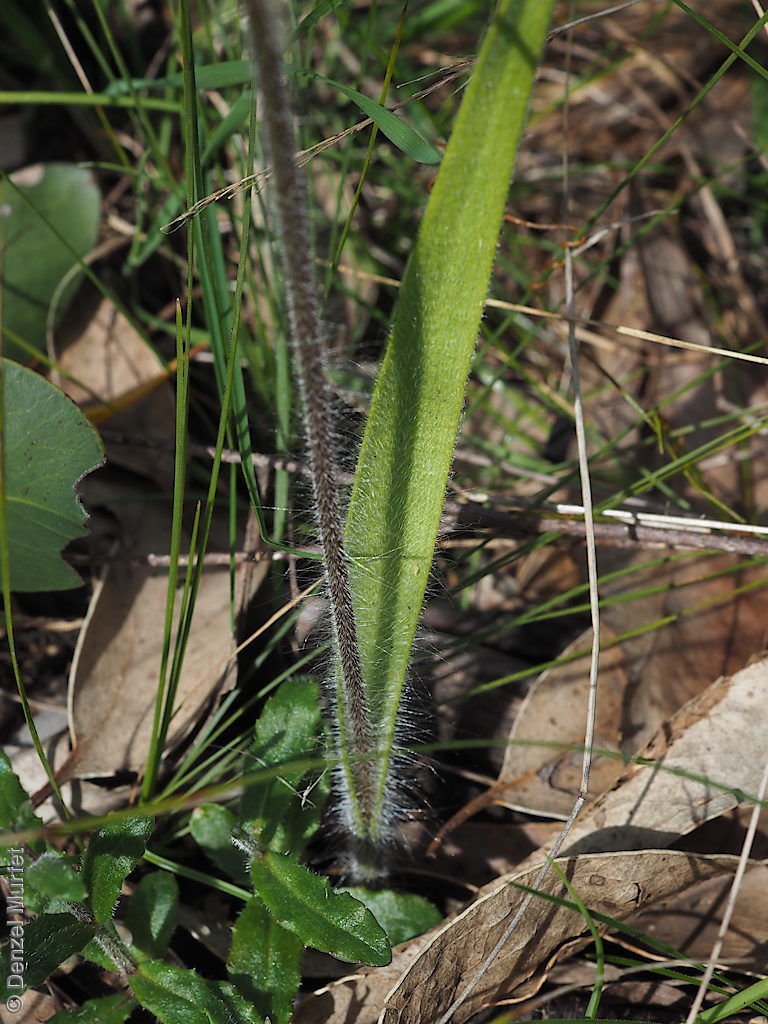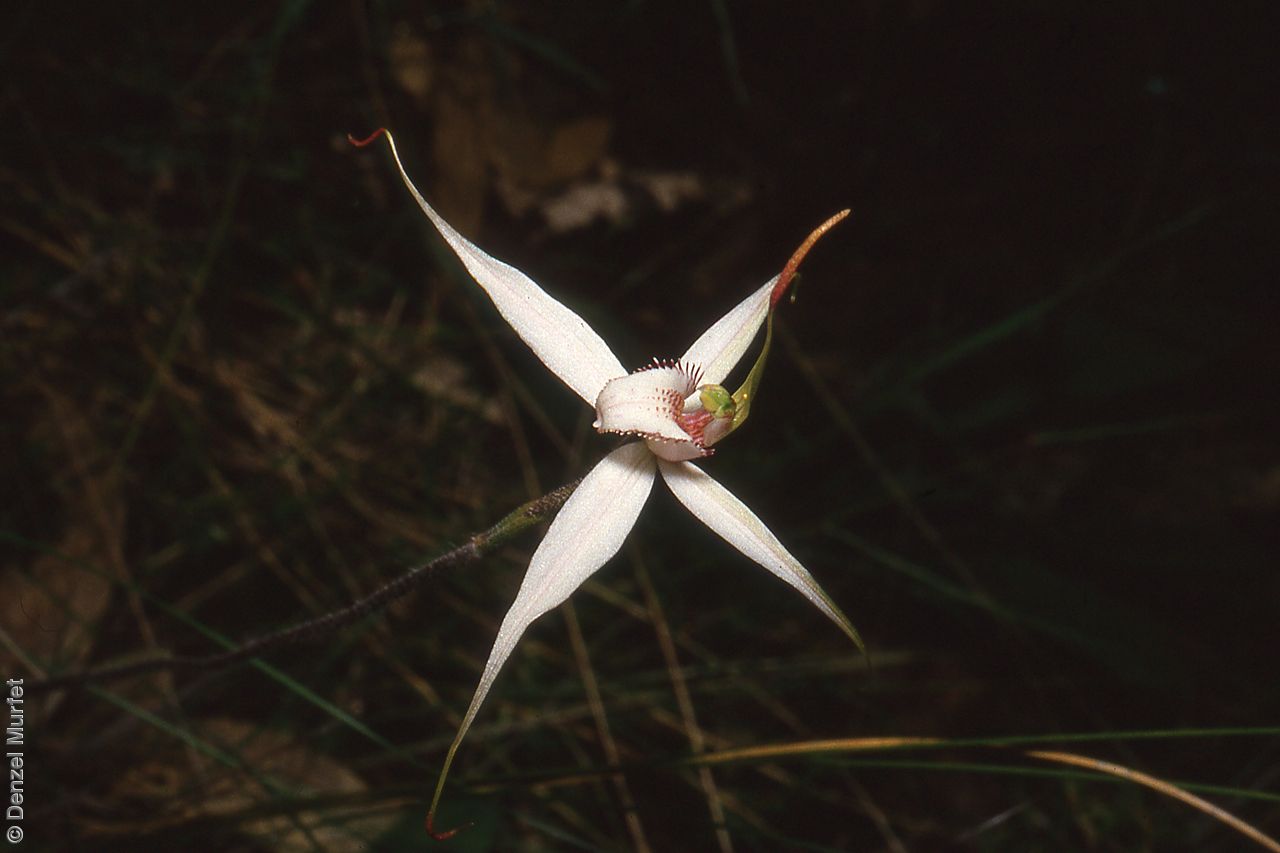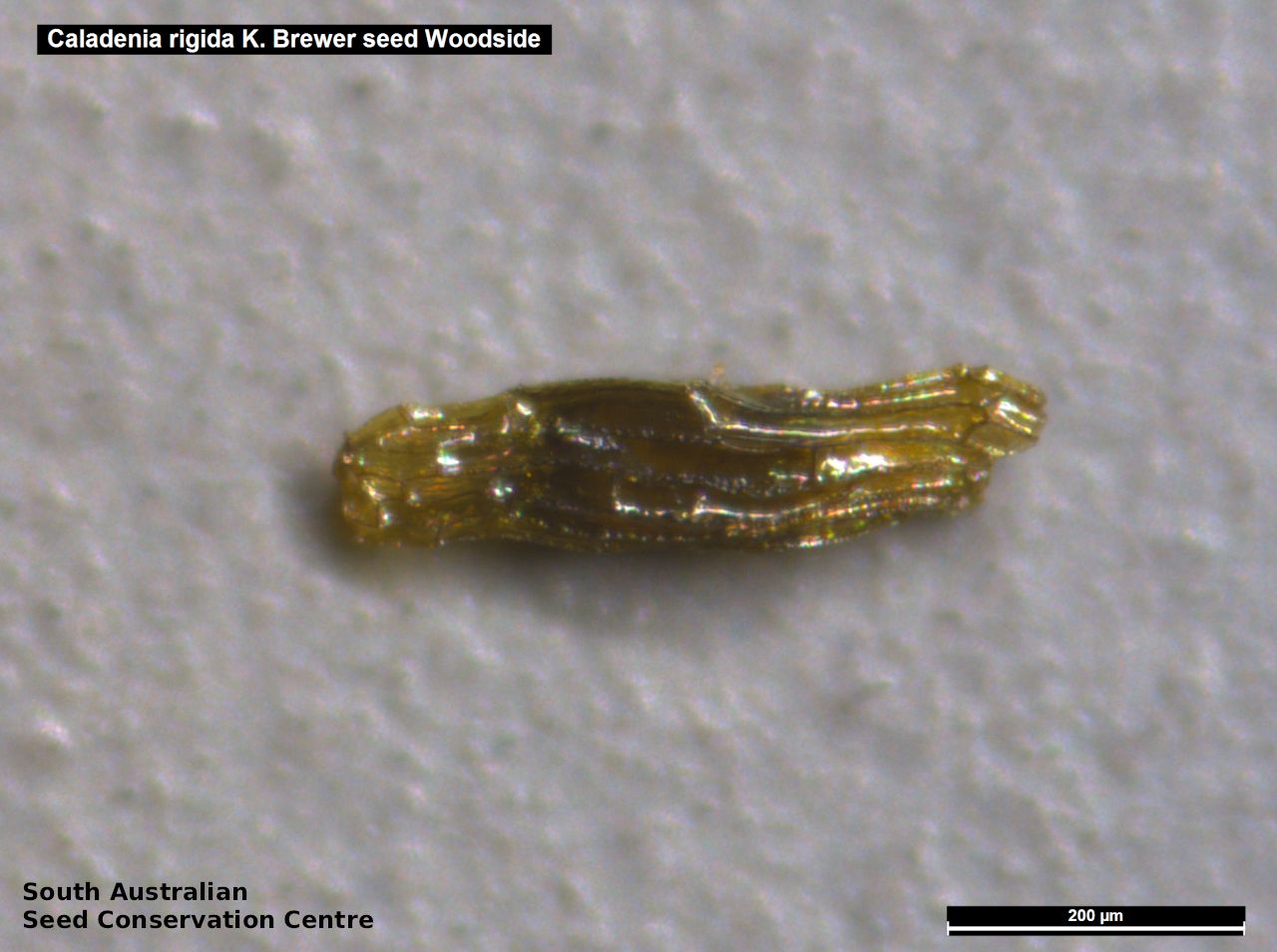
















Botanical art
Prior names
Calonemorchis rigida
Arachnorchis rigida
Calonema rigidum
Caladenia huegelii var. rigida
Common names
Adelaide Hills White Spider-orchid
Stiff White Spider-orchid
Etymology
Caladenia from the Greek 'kallos' meaning beauty and 'aden' meaning a gland, referring to the colourful labellum and the glistening glands at the base of the column that are present in many of the species. Rigida from Latin meaning stiff, rigid or inflexible, referring to the perianth segments which spread rigidly rather than drooping.
Distribution and status
Endemic to the southern Mount Lofty Ranges in South Australia and found between Macclesfield in the south and Williamstown in the north, growing on ridge tops and hillslopes in grey-brown loam often associated with coarse quartzite gravel or sandstone pebbles in open woodland dominated by Eucalyptus obliqua, E. goniocalyx, E. leucoxylon, E. fasciculosa and E. microcarpa. Native. Endangered in South Australia. Endangered in Australia (EPBC Act).
Herbarium regions: Southern Lofty, Green Adelaide
NRM region: Adelaide and Mount Lofty Ranges
AVH map: SA distribution map (external link)
Plant description
Slender terrestrial orchid with a hairy flowering stem to 30 cm in flower. Leaves narrow-lanceolate, to 20 cm long, single, hairy. Flowers 1-2, to 5 cm wide, white with red marks on the calli and labellum fringe, not fragrant. Dorsal sepal erect and incurved over the column and terminates in a dark red, glandular club. Lateral sepals are rigidly spreading, and have similar clubs to the dorsal sepal. Labellum ovate, to 1 cm long, white with red-brown subulate marginal teeth and four rows of calli that are mostly basally club-shaped and red with white tips. Flowering between August and October. Fruits are pale-brown hairy, papery ellipsoid capsule.
Seed collection and propagation
Collect seeds between late October and November. Collect fat capsules as they start to dry and turn brown. Pods will split and release the seeds quickly and will require monitoring. To increase the chances of collecting mature pods, it is recommended that a small breathable bag (ie. Organza bags) be used to enclose the developing capsules. Place the capsules in a container that will hold fine seeds and leave to dry for a few weeks or until the capsule split. Then carefully hold the capsule and tap it gently to release the seeds. Store the seeds with a desiccant such as dried silica beads or dry rice, in an air tight container in a cool and dry place, refrigerator or in liquid nitrogen.
| Location | No. of seeds (weight grams) | Number of plants | Date collected | Collection number Collection location | Date stored | % Viability | Storage temperature |
|---|---|---|---|---|---|---|---|
| 7-Nov-2007 | J. Quarmby Southern Lofty | 1-Nov-2016 | N/C | -80°C | |||
| 7-Nov-2007 | J. Quarmby Southern Lofty | 1-Nov-2016 | N/C | -80°C | |||
| 9-Nov-2005 | J. Quarmby Southern Lofty | 1-Nov-2016 | N/C | -80°C | |||
| 7-Nov-2007 | J. Quarmby Southern Lofty | 1-Nov-2016 | N/C | -80°C | |||
| 2 pods | 5-Nov-2008 | J. Quarmby Southern Lofty | 1-Nov-2016 | N/C | -80°C | ||
| 7-Nov-2007 | J. Quarmby Southern Lofty | 1-Nov-2016 | N/C | -80°C | |||
| 17-Nov-2007 | J. Quarmby Southern Lofty | 1-Nov-2016 | N/C | -80°C | |||
| 7-Nov-2007 | J. Quarmby Southern Lofty | 1-Nov-2016 | N/C | -80°C | |||
| 3-Nov-2009 | J. Quarmby Southern Lofty | 1-Nov-2016 | N/C | -80°C | |||
| 27-Oct-2009 | J. Quarmby Southern Lofty | 1-Nov-2016 | N/C | -80°C | |||
| 21-Nov-2005 | R. Faast Southern Lofty | 1-Nov-2016 | N/C | -80°C | |||
| 9-Nov-2005 | J. Quarmby Southern Lofty | 1-Nov-2016 | N/C | -80°C | |||
| 8-Nov-2007 | J. Quarmby Southern Lofty | 1-Nov-2016 | N/C | -80°C | |||
| 21-Nov-2005 | R. Faast Southern Lofty | 1-Nov-2016 | N/C | -80°C | |||
| 17-Nov-2005 | R. Faast Southern Lofty | 1-Nov-2016 | N/C | -80°C | |||
| 9-Nov-2005 | J. Quarmby Southern Lofty | 1-Nov-2016 | N/C | -80°C | |||
| 9-Nov-2005 | J. Quarmby Southern Lofty | 1-Nov-2016 | N/C | -80°C | |||
| 8 pods | 8-Nov-2007 | J. Quarmby Southern Lofty | 1-Nov-2016 | N/C | -80°C | ||
| 17-Nov-2007 | J. Quarmby Southern Lofty | 1-Nov-2016 | 50% | -80°C | |||
| 7-Nov-2007 | J. Quarmby Southern Lofty | 1-Nov-2016 | N/C | -80°C | |||
| 2-Nov-2007 | J. Quarmby Southern Lofty | 1-Nov-2016 | N/C | -80°C | |||
| 2-Nov-2007 | J. Quarmby Southern Lofty | 1-Nov-2016 | N/C | -80°C | |||
| 13 pods | 4-Nov-2008 | J. Quarmby Southern Lofty | 1-Nov-2016 | N/C | -80°C | ||
| 9-Nov-2005 | J. Quarmby Southern Lofty | 1-Nov-2016 | N/C | -80°C | |||
| 8-Nov-2007 | J. Quarmby Southern Lofty | 1-Nov-2016 | N/C | -80°C | |||
| 8-Nov-2007 | J. Quarmby Southern Lofty | 1-Nov-2016 | N/C | -80°C | |||
| 2-Nov-2007 | J. Quarmby Southern Lofty | 1-Nov-2016 | N/C | -80°C | |||
| 2-Nov-2007 | J. Quarmby Southern Lofty | 1-Nov-2016 | N/C | -80°C | |||
| 1 pod | J. Quarmby Southern Lofty | 1-Nov-2016 | N/C | -80°C | |||
| 3 pods | 4-Nov-2008 | J. Quarmby Southern Lofty | 1-Nov-2016 | N/C | -80°C | ||
| 7-Nov-2005 | J. Quarmby Southern Lofty | 1-Nov-2016 | N/C | -80°C | |||
| 17-Nov-2007 | J. Quarmby Southern Lofty | 1-Nov-2016 | N/C | -80°C | |||
| 2 pods | 7-Nov-2007 | J. Quarmby Southern Lofty | 1-Nov-2016 | N/C | -80°C | ||
| 2-Nov-2007 | J. Quarmby Southern Lofty | 1-Nov-2016 | N/C | -80°C | |||
| 2-Nov-2007 | J. Quarmby Southern Lofty | 1-Nov-2016 | N/C | -80°C | |||
| 9-Nov-2007 | J. Quarmby Southern Lofty | 1-Nov-2016 | N/C | -80°C | |||
| BGA | 190,000 (0.068 g) | 12 | 23-Oct-2019 | Woodcutter, Coromandel East Southern Lofty | 24-Jun-2020 | N/C | -18°C |
| BGA | 200,000 (0.72 g) | 9 | 23-Oct-2019 | TST1426 Southern Lofty | 24-Jun-2020 | N/C | -18°C |
| BGA | 61,600 (0.022 g) | 4 | 23-Oct-2019 | TST1427 Southern Lofty | 24-Jun-2020 | N/C | -18°C |
| BGA | 54,900 (0.019 g) | 3 | 7-Nov-2018 | K.H.Brewer Southern Lofty | 28-Jun-2021 | -18°C | |
| BGA | 64,400 (0.023 g) | 3 | 28-Sep-2017 | K. Brewer Southern Lofty | 28-Jun-2021 | N/C | -18°C |
| BGA | 77,300 (0.028 g) | 7 | 15-Nov-2020 | K.H.Brewer Southern Lofty | 28-Jun-2021 | N/C | -18°C |
| 6 pods | 29-Jun-2005 | J. Quarmby Southern Lofty | 10-Aug-2022 | N/C | -80°C | ||
| 3-Nov-2009 | J. Quarmby Southern Lofty | 10-Aug-2022 | N/C | -80°C | |||
| BGA | 77,000 (0.028 g) | 3 | 4-Nov-2021 | Woodcutters Southern Lofty | 10-Aug-2022 | N/C | -18°C |
| 1-Oct-2007 | J. Quarmby Southern Lofty | 10-Aug-2022 | N/C | -80°C | |||
| 2 pods | J. Quarmby Southern Lofty | 10-Aug-2022 | N/C | -80°C | |||
| BGA | 465,100 (0.166 g) | 21 | 8-Nov-2022 | TST1497 Southern Lofty | 21-Jun-2023 | N/C | -18°C, -80°C |
Number of plants: This is the number of plants from which the seeds were collected.
Collection location: The Herbarium of South Australia's region name.
% Viability: Percentage of filled healthy seeds determined by a cut test or x-ray.